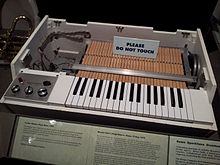User:DMartinSmith/sandbox
Present Day: Lo-fi Hip Hop[edit]
Main article: Hip Hop[edit]
Stemming from past sub genres of Lo-fi music such as vaporwave and chillwave, lo-fi hip hop has become much more relevant as lo-fi producers like [[Nujabes]] and [[J Dilla]] created a gateway for upcoming artists. Similar to other genres of lo-fi, lo-fi hip hop features the same distorted, and grungy sound while also providing mellow melodies to create introspective and chill tracks. Lo-fi hip hop is heavily connected to the media world as well. Nujabes produced many tracks for an anime show called samurai champloo which was a milestone in his career. The internet has completely embraced lo-fi hip hop, as it is commonly connected to anime and has actually become quite popular amongst the masses, and yet with such modern influences, the process of making lo-fi hip hop still utilizes vintage and authentic equipment such as vinyls and sampling [46] cuts from older tracks. Artists such as knxwledge utilize sampling in a way that creates psychedelic and melodic tracks that also integrate multiple cuts from newer and older tracks. This newer sub-genre has opened doors for female artists to make a name for themselves as well. Rising female voices include top female lo-fi producer, Eevee, lyricist Sophie Meiers, and much more. This sub-genre continues to grow as more people discover it. Rising from the underground lo-fi hip hop continues to open doors for its listeners and its audience.
Sampling[edit]
The definition of sampling is "the act of taking a portion, or sample, of one sound recording and reusing it as an instrument or a sound recording in a different song or piece.”[1] Sampling was used much more frequently in earlier dates such as the 60's, mainly because copyright rules and regulations were much more relaxed during those times. Artists such as [[Jimmy Castor]], [[Elvis Presley]], and [[The Beach Boys]] were among some of the first early artists to use the method of sampling. In fact, Jimmy Castor was among the first few artists to sue over sampling in the dispute with the [[Beastie Boys]] over the use of his song "The Return of Leroy (Part One). The dispute was settled outside of court and Castor would receive a percentage of the amount of copies sold of the Beastie Boys song: "Hold It! Hit It!".
Sample Users[edit]
thumb|Kanye West's 2005 "Late Registration" Album Notable Sample users in the Hip Hop genre include rapper and producer Kanye West as well as producer J Dilla. Kanye West has numerous tracks with samples from older tracks, one of them being "Touch The Sky" off of his 2005 "Late Registration" album. The song uses a sample from singer and song-writer Curtis Mayfield's "Move On Up" which was released in 1970. A big name producer in the lo-fi world who goes by the name of Wun Two, has sampled countless tracks in his abundance of beats. The long list of samples includes: "Michelle" by The singers unlimited from 1972, "Again" by Doris Day and the MelloMen from 1949, "Breezin'" by George Benson from 1976, "Flamingo" by Erroll Garner from 1949, and the list continues to go on. You can see the variation of time periods and song genres that these artists choose to sample from and how it impacts the lo-fi community as a whole. Sampling is essentially a cultural norm in relation to the music world, including lo-fi hip hop due to the fact that the majority of producers prefer sampling opposed to creating tracks from scratch.
Technology and Process[edit]

A sample is a digital portion of an existing recording or recorded sound/noise. The audio signal is recorded by a microphone or a direct line/mic input on a piece of equipment which can digitalize an analogue signal via an AD converter. During the sampling process, these signals are measured in short intervals. The bitrate determines how many samples are measured. The more a sample is analyzed for a specific period of time, the more accurately the waveform (the analogue source signal) will be emulated (see the diagram on the right). Of course, you can also play this collection of measured sounds back onto analogue equipment again.[2]. Technically a sample can be any digital audio recording. However, the term is usually referring to short fragments like: Short percussive samples (drums, metallic sounds, synth noises etc), Loops (drum loops /beats and/or complete melody loops), Spoken word/vocals, Noises from nature and our day to day environment, Effects (synth sounds, manipulated tones, etc.), Instrument samples (which can be reproduced with a MIDI keyboard, and playable instruments – usually ‘multi-samples’) [3]
The first piece of sampling machinery originated in the 1960's and was called the Mellotron which used magnetic tape. Present day artists and producers use a mix of both software and hardware to create samples. Electronic companies such as Akai have been making products-such as the early dated 16-bit sampler-which have been revolutionizing the producing world since it was first erected.
Lofi Hip-Hop And Pop Culture[edit]
Lofi hip-hop can give alot of credit to youtube for its success within popular culture. Many Youtube channels feature a 24/7 livestream of Lofi hip-hop which contain music from multiple artists within the sub-genre including but not limited to: Elijah Who, Wun Two, FloFilz, and much more. Youtube channels such as Chilled Cow, Chillhop Records, and The Bootleg Boy have gained popularity by making mixes and providing livestreams of Lofi hip-hop. Chillhop Records hosted the most popular lofi hip-hop livestream with over 10,000 listeners joining every hour [4]. Unfortunately, the video had been taken down due to copyright issues yet, with such a strong following the channel's founder has been working with third-party groups to bring the video back.
- ^ "THe Art of Sampling in Hip-Hop (90s to Present) | MUSC 204: Popular Music in Black America". blog.umd.edu. Retrieved 2018-04-25.
- ^ https://www.imusiciandigital.com/en/sampling-technology-effects-part-1/
- ^ https://www.imusiciandigital.com/en/sampling-technology-effects-part-1/
- ^ https://www.polygon.com/2018/2/8/16990594/youtube-lofi-hip-hop-gaming-livestream-anime-wolf-children
